

WTTC: Seamless biometric technology will transform traveler experience
Passengers will be able to move more efficiently, faster and securely through every part of the travel experience after the World Travel & Tourism Council (WTTC), the body which represents the global private sector for Travel & Tourism announced a series of pilot schemes to test the use of biometric technology throughout the end-to-end passenger journey.
In first half of 2019, passengers will be able to trial the application of biometric technology at every stage of the travel process – from the point of booking, check-in, through airports, airline boarding, border management, car hire, hotel, cruise and during the journey.
In a series of pilot schemes being facilitated by WTTC, under its Seamless Traveler Journey initiative, representatives from several industries within the Travel & Tourism sector, such as airlines, airports, hospitality, cruise, car rental, and tour operators, will be able to jointly test different technologies that interconnect and work to improve the experience of the traveler.
The first pilot will see travelers on round-trips between Dallas Fort Worth International Airport or London using biometric technology to conduct all airline security, airport and border processes before accessing car rental and hotel check-in using the same biometric information.
WTTC is working with American Airlines, Dallas Fort Worth International Airport, Hilton, and MSC Cruises on plans for this first step towards the immense task of changing how people will travel which will have profound benefits for the traveler and the future of the industry. All of these corporations and the members of WTTC share a commitment to making the travel process safer and more efficient through the use of biometric technology.
WTTC has also invited the United States Customs and Border Protection and UK Border Agency to collaborate on the first pilot.
Consulting firm Oliver Wyman is supporting WTTC with the overall Seamless Traveler Journey program.
Gloria Guevara, President & CEO, WTTC, said: “In 2019 travelers between Dallas Fort Worth International Airport and London will be able to experience the future of travel. Our vision is that the traveler won’t need to provide the same information or passport multiple times. Instead, their experience will be seamless, faster and more enjoyable throughout their entire journey. Biometrics will work at every touchpoint of the journey to make travelling easier for the passenger while providing border services with greater security.
“99.9% of travelers are considered low risk. By using technology to minimize queues, we can give low-risk travelers more time to enjoy the travel experience. These travelers, by using technology, will be able to spend their time enjoying the experience, shopping at airports or more time at destinations rather than worrying about long queues.
“Travel & Tourism employs one in ten people on the planet today and over the course of the next 20 years we will witness a doubling of the number of travelers and the creation of as many as 100 million jobs around the world. We have a responsibility to prepare for the future by transforming the traveler experience while increasing security by working together and with governments.”
Chris Nassetta, Chairman of WTTC, and President & CEO of Hilton, added, “In our industry, our customers are at the heart of everything we do – we are always looking for new ways to offer them exceptional experiences. In the near future, travelers will begin to see biometric technologies that will enhance many elements of their journey from start to finish. Thanks to the support of our partners around the world, WTTC is helping create seamless experiences for travelers, encouraging the sustainable growth of travel and tourism.”
Sean Donohue, CEO of Dallas Fort Worth International Airport, said “As we look ahead to transforming the customer experience through technology and personal touchpoints, we’re pleased that DFW is part of this industry-leading effort. International airports are uniquely positioned in the customer journey, providing a key connection between air and ground transportation, hotels, and government agencies. We’re confident the WTTC pilot program will lead to an even better customer experience and more efficiencies for businesses and agencies across the travel and tourism industry.”

The 12th UNWTO/PATA forum looks into the future of tourism
The World Tourism Organization (UNWTO), the Pacific Asia Travel Association (PATA) and the People’s Government of Guilin, China held the 12th UNWTO/PATA Forum on Tourism Trends and Outlook on 25-27 October 2018. This year’s edition – ‘The Future of Tourism: Road to 2030´, aligns with the 2030 Agenda for Sustainable Development and the Sustainable Development Goals (SDGs).
“Digital advances provide opportunities to tourism in order to enhance inclusiveness, community empowerment and efficient resource management to achieve the SDGs. Yet to do so, we need to better understand where tourism is heading so we can adopt the adequate policies and business strategies.” said UNWTO Executive Director Shanzhong Zhu at the event.
International tourist arrivals in Asia and the Pacific grew 6% in 2017 to reach a total of 323 million. Rapid economic growth in emerging economy markets, rising air connectivity, more affordable travel and enhanced visa facilitation continue to fuel tourism from within and outside the region. Asian destinations earned USD 390 billion in international tourism receipts in 2017, 29% of the global figure, a share that has steadily increased from 17% in 2000. China, the world´s top spender in international tourism and fourth largest destination, has been one of the main drivers behind this growth.
Dr. Ian Yeoman, travel and tourism futurologist, delivered the keynote speech on the future of tourism, highlighting the importance of societal behaviours towards a sustainable future and the distribution of wealth generated by tourism, as main drivers of change.
Furthermore, topics covered at the Forum included how digital advances and data can be used to support sustainable tourism for development. Presentations were made by Google, TripAdvisor, Vynn Capital, STR, the European Travel Commission as well as research and policymakers from across different countries in Asia and the Pacific. The Forum concluded by emphasising the need for transformation and seize the opportunities brought by innovation and technology to move sustainability to the next level.
The 12th UNWTO/PATA Forum on Tourism Trends and Outlook drew more than 220 experts from 22 countries, among which representatives from National Tourism Administrations, National Tourism Organizations, tourism businesses and academics. With the longstanding collaboration of the Hong-Kong Polytechnic University, the Forum has become over the last 12 years a reference platform on global and regional tourism trends.
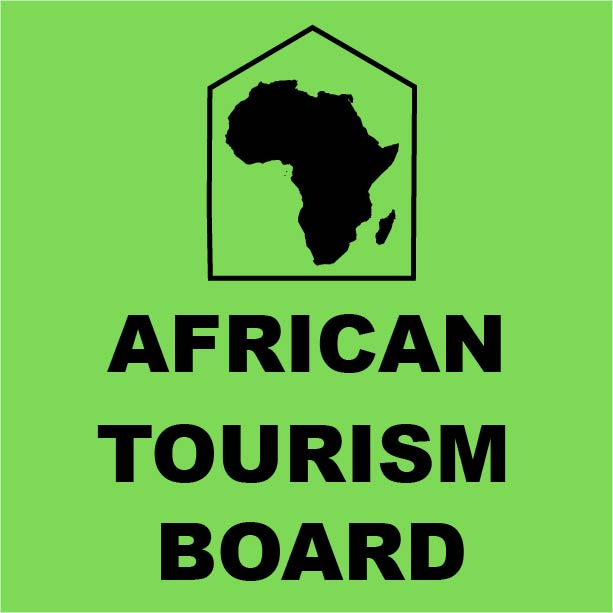
Reshaping African Tourism at World Travel Market in London
The African Tourism Board soft launch at the upcoming World Travel Market (WTM) in London wants to bring Africa together and take tourism leadership home with one goal in mind: “Where Africa becomes one tourist destination.”
African travel and tourism leaders are expected to meet at WTM on Monday, November 5, 2018 at 1400 hours at North Gallery Room 4 at the Excel Exhibition Center to participate in the soft launch of the African Tourism Board (ATB).
The soft launch is sponsored by Carol Weaving, managing director of Reed Exhibitions, who is one of the new board members of ATB. The event is co-sponsored by a prominent figure who doesn’t yet want to be named.

Attending Ministers of Tourism from across Africa, CEOs of tourism boards, and leaders of the private travel and tourism industry in Africa and around the globe are expected to share their stories. Global tourism celebrities, including Dr. Taleb Rifai, former UNWTO Secretary-General, confirmed attendance. It’s expected Dr. Rifai will share information on the outcome of the International Tourism Investment Launch in London. Rifai is the Chairman, and their launch event is scheduled for November 2 in London. ATB will be an observer at the International Tourism Investment Launch event.
ITIC is designed to serve as a unique global investment platform that will bring together investors, private equity firms, bankers, family offices, law firms, and technology experts alongside tourism policy-makers and ministers, experts, CEOs from the public and private sectors, and tourism entities as one tourism-focused business community to unlock opportunities for tourism countries strongly reliant on tourism as a foundation for national growth and development.
Where Africa becomes one destination is the theme for the African Tourism Board. Topics at the soft launch will include global tourism outreach, travel, tourism security, investments, Internet access in Africa, aviation connectivity, sustainability, marketing, and building a “friends of the media” platform.
The full agenda will be announced Wednesday. A sneak preview:
 Former Seychelles Minister of Tourism, Alain St. Ange, will speak about “Africa rewriting its narrative to re-position itself as a relevant tourism destination.”
Former Seychelles Minister of Tourism, Alain St. Ange, will speak about “Africa rewriting its narrative to re-position itself as a relevant tourism destination.”
Professor Geoffrey Lipman, co-founder of SUNx and President of ICTP (International Coalition of Tourism Partners), will introduce a never-announced concept, “Climate-friendly Travel for Africa,” and a scholarship opportunity for African youth.
Graham Cooke, head of World Travel Awards, will be explaining the upcoming partnership between World Travel Awards and the African Tourism Board.
Carol Weaving, Managing Director of Reed Expo, will deliver her views on why forming the African Tourism Board is timely.
ICTP Chairman Juergen Steinmetz will shed light on why the Hawaii, Brussels, Seychelles, and Bali-based International Coalition of Tourism Partners started the African Tourism Board. He will share his vision on where ATB could go, and when ATB will be officially launched. He will introduce an initial steering committee and board ready to take the African Tourism Board home to Africa and to the next step on its path to help the continent to become one powerful and sustainable travel and tourism destination.
Registration for the ATB soft launch event is open. Space is limited.
Click here to register.
Founded in 2018, the African Tourism Board is an association that is internationally acclaimed for acting as a catalyst for the responsible development of travel and tourism to and from the African region.
The African Tourism Board is part of the International Coalition of Tourism Partners (ICTP)
The Association provides aligned advocacy, insightful research, and innovative events to its members.
- In partnership with private and public sector members, the African Tourism Board enhances the sustainable growth, value, and quality of travel and tourism to, from, and within Africa.
- The Association provides leadership and counsel on an individual and collective basis to its member organizations.
- The Association is expanding on opportunities for marketing, public relations, investments, branding, promoting, and establishing niche markets.
More information and how to join the African Tourism Board can be found at africantourismboard.com.
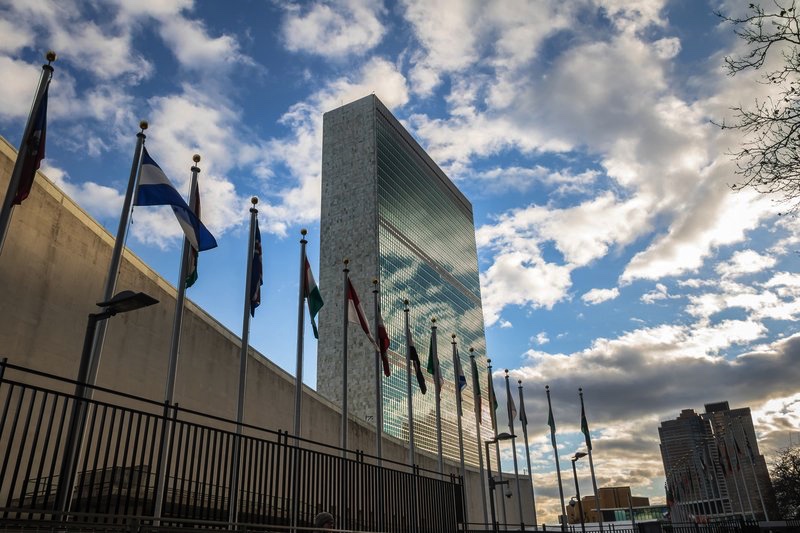
New UNWTO Global Report on Inclusive Tourism Destinations launched on the occasion of UN Day 2018
A new report by the World Tourism Organization (UNWTO), produced in collaboration with UNWTO Affiliate Member globaldit, presents a model for inclusive tourism destinations. ‘Global Report on Inclusive Tourism: Model and success stories” is launched on the occasion of the UN Day 2018 celebration in Madrid, Spain.
Modelling inclusive tourism destinations on the capacity of tourism to integrate disadvantaged groups and benefit from its activity, is at the centre of this report. Showcasing how tourism can function as a vehicle for sustainable development, and the reduction of poverty and inequality, in the context of the 2030 Agenda and the 17 Sustainable Development Goals (SDGs).
The Model for inclusive tourism destinations presented in this Global Report contributes directly to SDG 8 – Decent work and economic growth and SDG 10 – Reduction of inequalities; but also SDG 5 – Gender equality and SDG 17 – Global partnership for sustainable development.
“As globalization, interconnectivity and a growing middle class leads to ever more people travelling, the world will continue seeming to get smaller and inclusion will become even more of a priority,” said UNWTO Secretary-General Zurab Pololikashvili. He added that this publication “will serve as an important tool for the tourism community to create and promote inclusion in destinations, and a valuable reference for all tourism stakeholders in developing best practices for a more inclusive sector”.
In addition, this report highlights the need to foster discussion on and examine new approaches to inclusive tourism in order to drive tourism’s long-term sustainability.
Various experts from organizations in the field of tourism and the SDGs contributed to this report: the Ashoka Foundation, the Global Sustainable Tourism Council, Google, IE University, PREDIF, the SDG Fund, Airbnb, Vinces, Walhalla DCS and Ekin Consulting. It also features success stories from a variety of stakeholders, such as the Gauteng Tourism Authority, Mekong Tourism Coordinating Office, CENFOTUR, Korea Tourism Organization, VisitScotland, Chemonics and the State of Michoacán, Mexico.
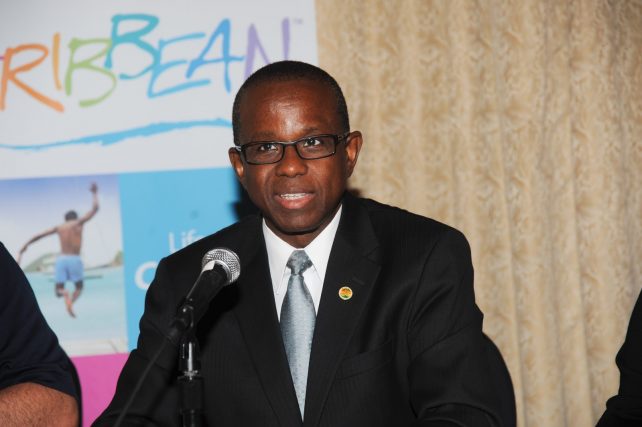
Caribbean Tourism: Complacency puts Caribbean people and economies at risk
Secretary General of the Caribbean Tourism Organization (CTO) Hugh Riley has called on Caribbean states to take tsunami preparedness seriously, stating to do otherwise would put the people and regional economies at risk.
Speaking in Paris, France, during a discussion organised by the United Nations Educational, Scientific and Cultural Organization (UNESCO) to raise awareness of the threats posed by tsunamis, Riley insisted that Caribbean countries risked paying the price for complacency.
He stressed with the Caribbean being comprised mainly of low-lying states, and with most tourism assets and hotel investments located at or near coastal areas, the tourism sector is extremely vulnerable to the threat of tsunamis.
“Tourism is the main economic driver of the Caribbean, representing 80 per cent of the region’s gross domestic product and more than one million jobs so we cannot ignore a tsunami risk,” he told fellow panellists and the wider audience, which included representatives from Grenada, Saint Lucia and St. Vincent & the Grenadines.
“Complacency puts us in real danger and we must raise the Caribbean’s voice by advocating for our members during this important global forum,” he added.
The event was being held in advance of World Tsunami Awareness Day on 5 Nov. 2018. The secretary general noted that the region had experienced 11 tsunamis in the past, the most recent of which occurred in 2010, and six between 1902 and 1997.
He suggested that because there has been no “recent” impact on the region, tsunamis are not considered an imminent threat, therefore, they are not given sufficient attention.
He called for an increase in tsunami awareness and sensitisation of the tourism sector and the wider Caribbean community, as well as support for training by regional institutions and countries to develop preparedness and response protocols.
“The CTO recognises that tsunami preparedness is critical, which includes well-established and tested response protocols which will ultimately reduce loss of life and economic damage. We also need to enhance collaboration with countries recently and frequently impacted by tsunami hazards in order to develop best practices.”
Riley highlighted several CTO members’ tsunami readiness initiatives, including Anguilla, the first English-speaking Caribbean island to be recognised as “tsunami ready” in September 2011 and has maintained certification status. Since then the British Virgin Islands and St. Kitts and Nevis have received similar recognition, all having established emergency operating centres, national tsunami plans, public outreach and alert systems, public service information programmes and tsunami preparedness and response protocols.
The high-level panel was organised by UNESCO’s Intergovernmental Oceanographic Commission (IOC) and the United Nations Office for Disaster Risk Reduction (UNISDR) to discuss policies and practices to reduce tsunami risks in countries highly dependent on tourism revenue.
The meeting opened with a minute’s silence in memory of the 2,000 confirmed dead and 680 officially missing in the tsunami and earthquake which struck Indonesia on 28 Sept. 2018. The double disaster left almost 70,000 people homeless and 11,000 injured in the Indonesian cities of Palu and Donggala in Central Sulawesi.

Just a Drop reaches 1.5 million people with safe water
Just a Drop will celebrate its 20thanniversary and having reached 1.5 million people with safe water and sanitation at World Travel Market 2018 – the event where the charity was launched in November 1998 by Fiona Jeffery OBE, former WTM Chairman.
To mark the occasion, Just a Drop has partnered with Water-to-Go to create Just a Drop-branded eco-friendly water bottles, which provide a solution to two of the biggest problems facing the world at the moment: access to clean, safe drinking water and the pollution caused by single-use plastics.
Containing a filtration system that eliminates over 99.9% of contaminants, the water bottles will be sold exclusively on Just a Drop’s stand at WTM (BL4 on the Main Boulevard, by N4/S4) for the special anniversary price of just £5, ahead of launching online via Water-to-Go’s website. All profits will support Just a Drop’s safe water projects. Free water refills will be available throughout WTM from water stations located around the fair, including at Affordable Car Hire, Air Europa, Atta – African Travel & Tourism Association, Discover the Palm Beaches, and Just a Drop’s stands.
Anniversary celebrations will take place on Just a Drop’s stand throughout WTM. A raffle will be held with prizes including a three-course meal with champagne for two at The Ritz, London, donated by Travelzoo.
Fiona Jeffery OBE, Founder and Chairman of Just a Drop, said: ‘I’m delighted to be celebrating Just a Drop’s 20th anniversary here at WTM, where it all began. Over the past 20 years Just a Drop has grown from a volunteer organisation providing emergency relief in the wake of natural disasters to a professional NGO working with local communities to deliver comprehensive safe water, sanitation and hygiene programmes that create sustainable, long-term change and empower people to lift themselves out of poverty. Just a Drop has now reached 1.5 million people with safe water and sanitation across 32 countries. This is an achievement I did not foresee when I launched the charity in 1998, and it has been made possible largely thanks to the travel industry’s generous and dedicated support – thank you.’
On World Responsible Tourism Day, Wednesday 7th November, Just a Drop will host ‘The Changemakers: How Inspiration has Created Life Transforming Reality’. Speakers Holly Budge, Founder of How Many Elephants, Fiona Jeffery OBE, Founder of Just a Drop, Paras Loomba, Founder of Global Himalayan Expedition, and Ben Morison, Founder of The Flipflopi Project, will discuss how they realized their ideas and created organisations that are changing the world we live in for the better. The talk will be moderated by Anita Mendiratta and will take place from 2-3 pm in the Middle East & Africa Inspiration Zone – AF190.
Just a Drop was founded at WTM in 1998 by Fiona Jeffery OBE, as a way of encouraging the travel industry to give back to communities around the world. Fiona chose the cause because water is the most basic of human needs, and she felt that if everyone was encouraged to give a little, then collectively a huge difference could be made.
Just a Drop’s first ever project began in Ethiopia in 1998 and much of the charity’s work during its first ten years involved disaster relief efforts, in partnership with organisations such as the British Red Cross and the Scientific Exploration Society. By 2008, Just a Drop’s work had contributed to the number of people without safe water dropping to below 1 billion globally, and the charity grew from a volunteer organisation to a professional NGO. The following ten years up to 2018 have seen Just a Drop develop into a community development organisation that today has reached over 1.5 million people across 32 countries with much needed safe water, sanitation and hygiene.

UNWTO/GTERC Report: Asia and the Pacific grows in importance for Global Tourism
The World Tourism Organization (UNWTO), in partnership with the Global Tourism Economy Research Centre (GTERC), presented its Asia Tourism Trends Report today at the Global Tourism Economy Forum in Macao (China). The report shows Asia and the Pacific outperforming all world regions in growth in international arrivals since 2005.
‘UNWTO/GTERC Asia Tourism Trends – 2018’ shows that international tourist arrivals in Asia and the Pacific grew 6% in 2017 to reach 323 million, around a quarter of the world’s total. Of all world regions, Asia and the Pacific, the second-most visited after Europe, has grown the fastest in international tourist arrivals since 2005. Arrivals increased an average of 6% per year, above the world average of 4%.
Rapid economic growth in a region with over half the world’s population, coupled with rising air connectivity, travel facilitation and large infrastructure projects, have boosted international travel in the region. This has had a large impact on Asian destinations’ tourism earnings, which have steadily increased from 17% of the world total in 2000 to 29% in 2017. This is equivalent to US$ 390 billion in tourism receipts.
Asia and the Pacific plays a vital role as a source market as well, fuelling much growth in both regional and long-haul destinations. The region produced 335 million international travellers spending US$ 502 billion in 2017, 37% of the world total. Around 80% of these visits were concentrated in Asia destinations. Outside the region, 56% of the long-haul trips were to Europe.
EU-China Tourism Year
To celebrate the EU-China Tourism Year 2018, the report looks at international tourism between China, the largest economy in Asia, and the block of 28 European Union (EU) countries.
It finds that 5.7 million Chinese tourists travelled to Europe in 2016, of which 3.5 million went to the EU. In reverse, 5.5 million Europeans travelled to China in 2016, 3.1 million of whom from EU countries.
China’s Greater Bay Area – a major outbound area
The last chapter of ‘UNWTO/GTERC Asia Tourism Trends – 2018’ provides an insight into the Greater Bay Area of China, a project to create a large socio-economic zone and tourism area comprising the two Special Administrative Regions of Hong Kong and Macao, as well as nine cities in Guangdong Province. According to the report, the Greater Bay Area is China’s fastest-growing tourism region and the Pearl River Delta home to several cities with high tourism development including Guangzhou, Shenzhen, Zhuhai and Foshan.
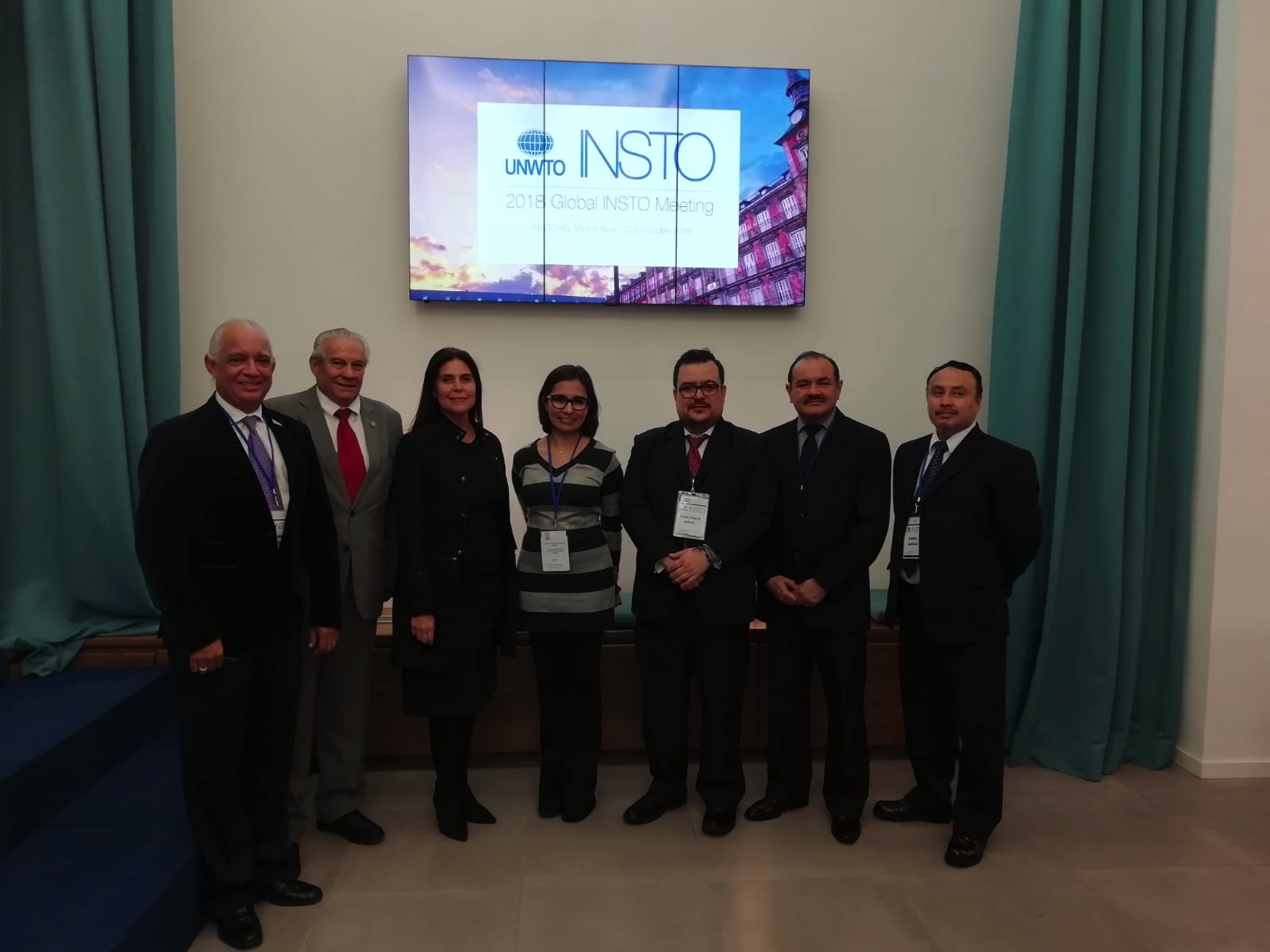
Spatial Data the Focus of UNWTO Sustainable Tourism Observatories Meeting
The World Tourism Organization’s (UNWTO) International Network of Sustainable Tourism Observatories (INSTO) concluded its global annual meeting today in Madrid, welcoming observatories and other tourism stakeholders to share experiences of measuring and monitoring the impact tourism has on destinations, and explore the opportunities provided to tourism by innovation in location services.
With a revamped structure featuring a mentoring breakfast, discussion rounds and workshops, this year’s Global INSTO Meeting focused on offering participants opportunities for interaction. Tourism stakeholders exchanged knowledge on achievements and challenges in measuring social, environmental and economic tourism impacts at destinations. In keeping with UNWTO’s priority of promoting technological innovation that fosters sustainable tourism, attendees took part in three workshops on the potential of geo-referenced information for destination planning.
Guests saw live demonstrations of spatial analysis, brainstormed project ideas using satellite images and learned how to build data dashboards. Such advances in location intelligence can support destinations create more transparent and timely communication and decision-making. The workshops were co-led by the destinations South Tyrol (Italy), Buenos Aires (Argentina) and Portugal in cooperation with private and public sector partners ESRi Spain, SEGITTUR and Vizzuality.
The 2018 Global INSTO Meeting also accepted two new observatories to the network – Panama City, Panama and South Tyrol, Italy – taking INSTO’s membership to 24. “Installing a project of this magnitude will allow us to continually measure the effects of tourism in a particular destination or region. We welcome this initiative with great enthusiasm considering the benefits that the entire tourism sector will receive in the short- and medium-term, and its positive impact on many other economic activities,” said Gustavo Him, Minister of Tourism of Panama, on joining INSTO.
“The decision to join the international observatory network brings with it the responsibility to shape South Tyrol’s development according to sustainability principles. For some years, South Tyrol has been establishing itself as a green region. We see this as another important step in that direction and recognize the value of sharing progress with other pioneer destinations,” said Arno Kompatscher, Governor of South Tyrol.

WTTC: Shanghai is largest tourism market in the world
Today, the World Travel & Tourism Council (WTTC) released its annual Cities Report at the WTTC Asia Leaders Forum in Macau, SAR. The Report covers 72 of the world’s most important tourism cities, which together generated over $625bn contribution to GDP last year (24.3% of global Travel & Tourism GDP).
The world’s top ten cities in terms of tourism market size are: Shanghai (US$35bn), Beijing ($32.5bn), Paris ($28bn), Orlando ($24.8bn), New York ($24.8bn), Tokyo ($21.7bn), Bangkok ($21.3bn), Mexico City ($19.7bn), Las Vegas ($19.5bn) and Shenzhen ($19bn).
The world’s top ten cities in terms of job creation are: Jakarta, Beijing, Mexico City, Shanghai, Bangkok, Chongqing, Delhi, Mumbai, Ho Chi Minh City, Shenzhen.
WTTC President & CEO Gloria Guevara commented, “With 54% of the world’s population living in urban areas, cities have become global economic hubs, driving growth and innovation. They attract huge quantities of people who travel to experience their culture, do business, and live. This growth has also resulted in a rise in city tourism – a trend which is forecasted to maintain momentum.
“Our Report highlights the crucial importance of cities to Travel & Tourism worldwide, and likewise how vital this sector is to the economy. Over half a billion trips are made to cities annually representing 45% of global international travel.”
Highlights from the Report include:
· Cairo was the fastest growing city in 2017 in terms of Travel & Tourism GDP contribution (34.4%), followed by Macau (14.2%).
· Four of the five fastest growing cities over the past ten years are located in China: Chongqing, Chengdu, Shanghai, Guangzhou.
· Shanghai is ranked as the largest city by Travel & Tourism volume in 2017. By 2027, Shanghai is expected to be double the size of Paris in terms of Travel & Tourism’s direct contribution to GDP.
· Bangkok (50.4%), Paris (29.8%), Mexico City (24.0%) and Tokyo (20.2%) are the biggest contributors to their country’s Travel & Tourism GDP.
· In terms of domestic vs. international spend, New York sets an example as a city with a remarkable balance (52.7% vs. 47.2%). Meanwhile, Paris relies heavily on international spend and Beijing on domestic.
China markets driving growth
Of particular note, Chinese cities have matured rapidly over the past decade, and are forecast to continue dominating the growth charts between 2017 and 2027. Shanghai, for example, went from being the 8th largest city in terms of Travel & Tourism GDP in 2007 to become the largest in 2017 – a position it is expected to maintain until 2027. Meanwhile, the rapid growth of Guangzhou will take it to 4th place, and Chongqing is forecast to join the top 15 for the first time. This comes following a period of sustained infrastructure development, including investments in airports and extensive product development.
The Chinese domestic and outbound markets will drive growth in the coming decade, with the majority of top performers maintaining their positions. Chinese cities will continue to lead, although a slowdown in growth is expected. With the exception of Marrakech, the cities in the top ten ranking of fastest growing Travel & Tourism GDP in the coming decade are in Asia-Pacific.
Guevara continued, “With such good performance of cities around the world, and the supreme growth experienced by cities in Travel & Tourism, comes huge opportunities. This Report illustrates the strength of Travel & Tourism and its economic impact not only at a macro-level but at the grassroots where it is relied upon every day. A vibrant tourism sector can stimulate investment, preserve and promote cultural heritage, and catalyse new activities such as research, technology or the creative economy.
“Planning for and managing growth so that it is inclusive and sustainable – with the well-being of the communities who live and work in such cities at its core – needs to be the top priority for city governments, working in partnership with the private sector.”
International arrivals into Asia Pacific continue to exceed the global average
Foreign arrivals into Asia Pacific destinations continued to grow at better than the global average in 2017, reaching a record volume high of more than 646 million arrivals relative to 2016.
According to the Annual Travel Monitor 2018 Final Edition (ATM) released by the Pacific Asia Travel Association (PATA) today, international visitor arrivals (IVAs) into 47 destinations in Asia Pacific covered in this report increased by 5.7 percent and added close to 35 million additional arrivals to the collective foreign inbound count into Asia Pacific in 2017.
In percentage increase terms between 2016 and 2017, the Pacific had the strongest annual increase at 5.9% year-on-year, followed by the Americas at 5.8%, while Asia kept pace with the Asia Pacific average of 5.7%.
By annual increase in the absolute volume of foreign arrivals however, these positions were reversed with Asia receiving close to 25 million additional foreign arrivals between 2016 and 2017, followed by the Americas with a gain of almost 8.6 million and the Pacific with around 1.4 million additional foreign arrivals received over that period.
Within the Americas, Central America showed the strongest incremental increase in foreign arrivals between 2016 and 2017, capturing 50.5% of the 8.577 million increase into the Americas over that period.
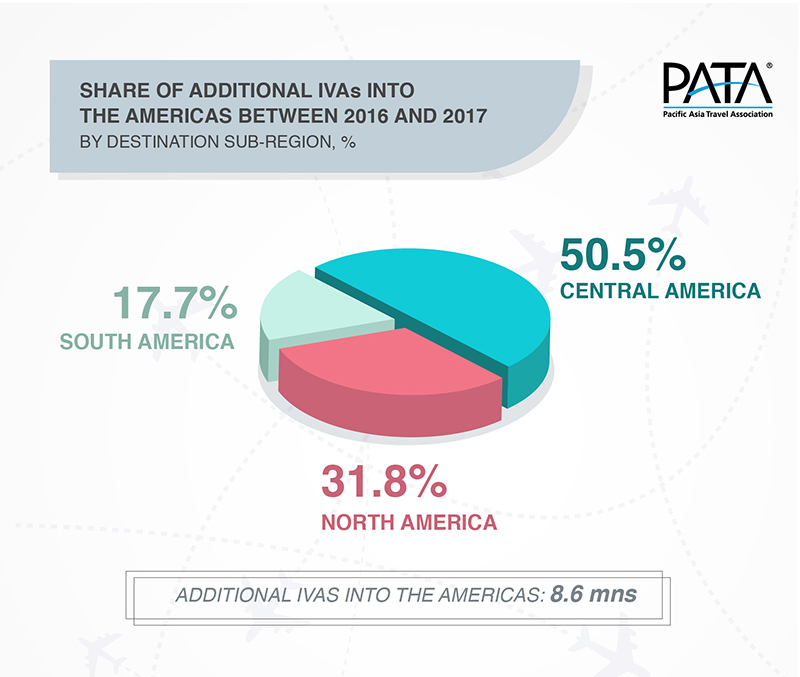
Across Asia it was Southeast and West Asia that each captured the largest proportion of additional foreign arrivals into Asia between 2016 and 2017.
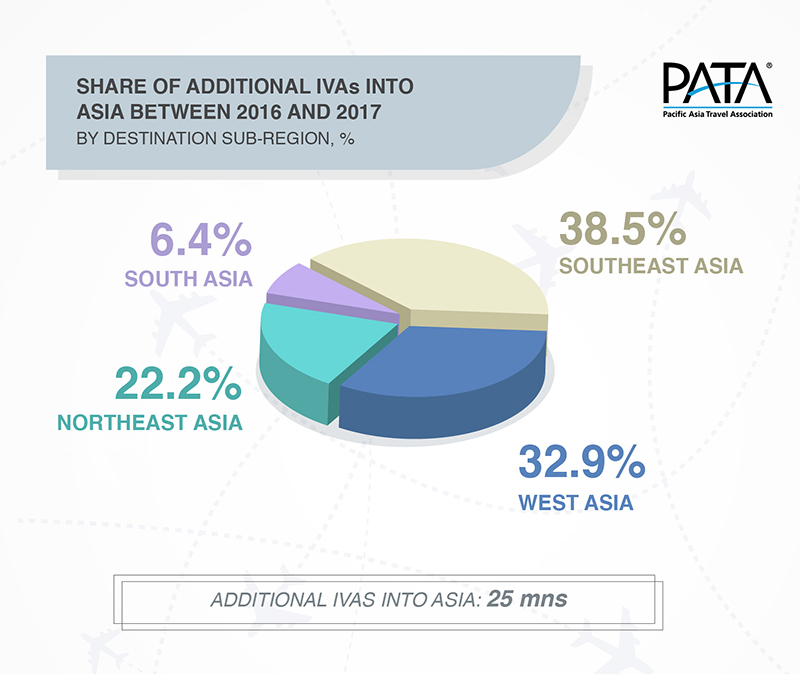
While in the Pacific, Oceania received more than half of the additional foreign arrivals into the region, followed by Polynesia.
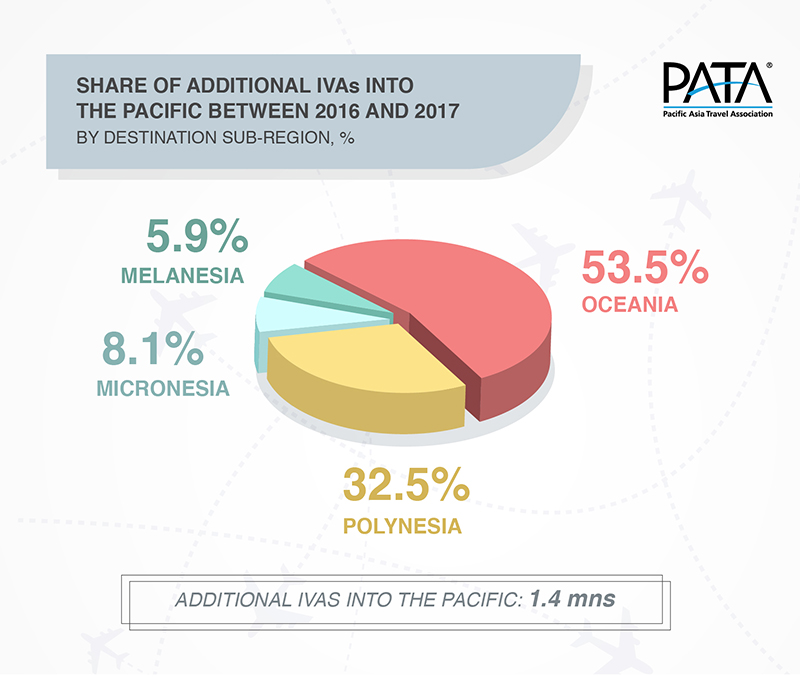
At the individual Asia Pacific destination level, destinations with the strongest annual percentage growth rates in 2017 ranked as:
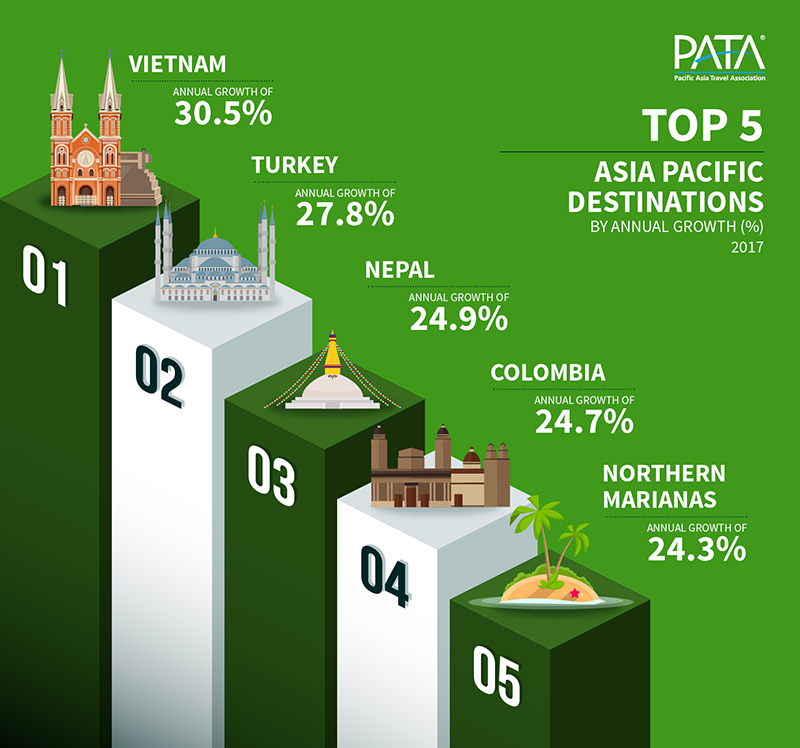
All told more than 40% of the 47 destinations covered in this report had annual growth rates in excess of 10%; another 28% had annual growth rates in excess of five percent.
For sheer annual volume increase between 2016 and 2017, the strongest Asia Pacific performers were ranked as:
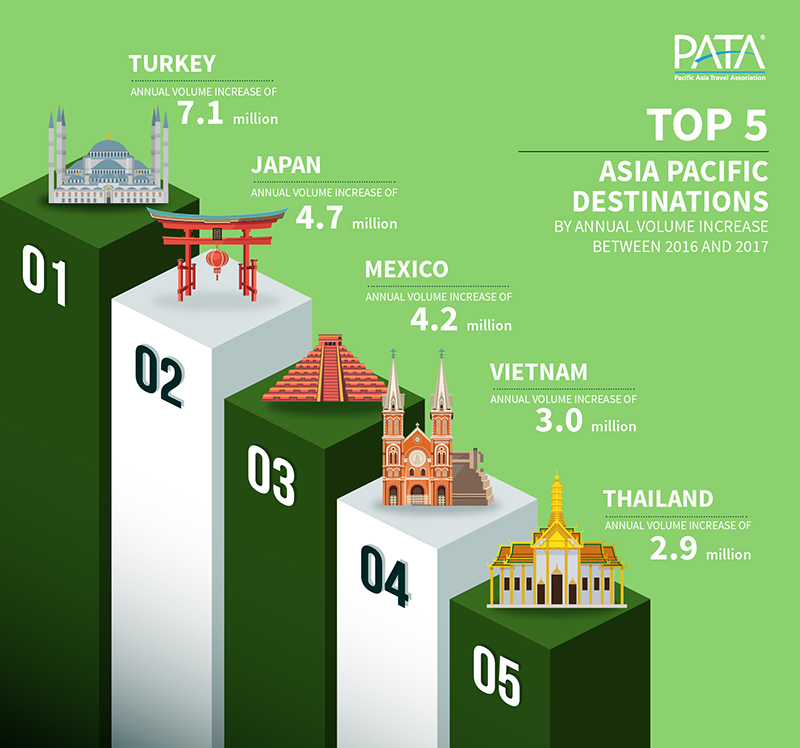
Of the destinations covered in this report, more than a quarter had annual volume increases of more than one million each, while close to 15% had between half a million and one million apiece.
The strong collective performance of Asia Pacific destinations in 2017 appears to be continuing into 2018 as well. As Dr. Mario Hardy, the CEO of PATA pointed out, “Early results for 2018 show a collective annual increase in foreign arrivals into Asia Pacific destinations of 8.7%, adding more than 25 million additional arrivals to the total inbound count during the first periods of 2018 relative to the same period of last year.”
Thirty-six Asia Pacific destinations had released year-to-date 2018 data on foreign arrivals at the time of preparing the Annual Tourism Monitor for 2018 and these are covered in some detail through the body of the report.
The strongest early performances are seen in a number of destinations including:
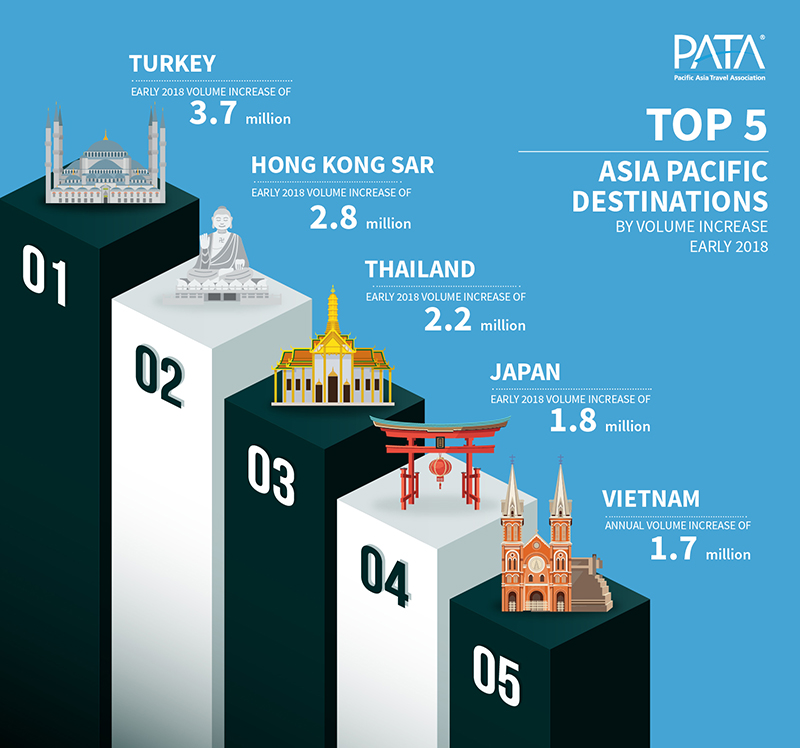
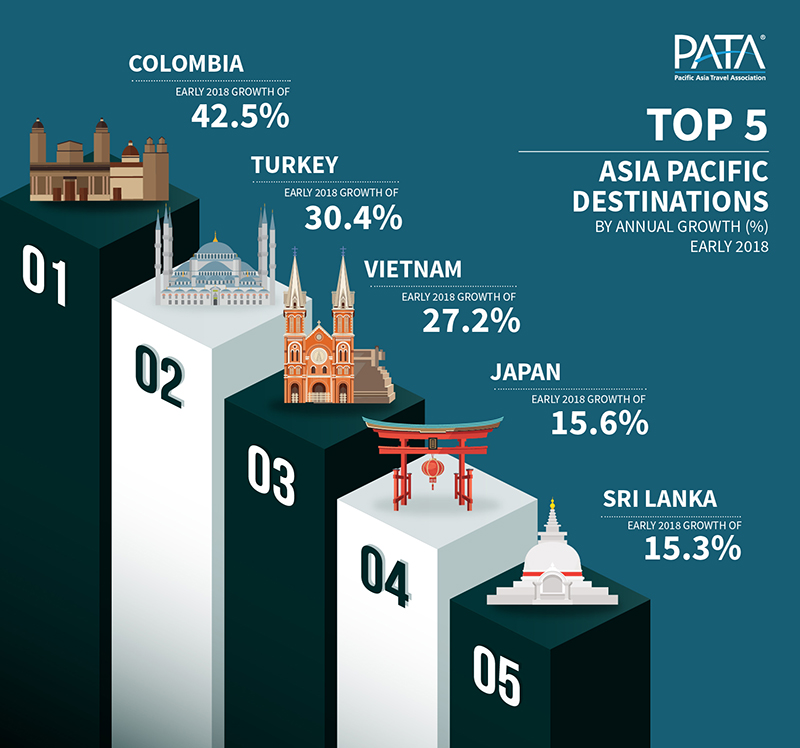
Furthermore, one quarter of these destinations had already posted volume increases of more than one million foreign arrivals in early 2018, relative to the same periods of 2017. Included amongst these are:
“In general terms, the volume of foreign arrivals into most Asia Pacific destinations now needs to be managed in terms of distribution across the destination, especially with growth rates remaining relatively high,” adds Dr. Hardy. “This includes shifting our focus from just the volume of arrivals to other performance metrics including length of stay and yield as primary indicators, along with developing a better and deeper understanding impacts of tourism on the environment and society at all levels, especially if we as a responsible economic sector wish to remain sustainable and therefore viable into the future.”
“It is not only the international travel flows that have an impact either. The domestic demand for new travel experiences is gathering momentum in many destinations as well, and when coupled with international visitor flows, that creates a very powerful dynamic. It is incumbent on us all to ensure that we can properly harness and manage that power or else risk losing those very attributes that drive visitor interest in the first place.”

